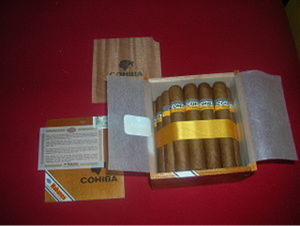Faking It, Making It: The Changing World of Knock-offs

Cuban cigars are expensive. A Cohiba robusto will set you back more than $25. You can buy them for much less. And lots of people do. Trouble is, they are fake.
People like me who have been smoking Cohibas for many years will tell you that it’s easy to tell the difference between a genuine and a counterfeit. The printing on the label may be a bit off – the wrong size or the wrong shade of yellow. Sometimes the size of the label is irregular. Or the quality of the paper is inferior. If you can’t spot a fake by examining the external evidence, you should notice the difference when you light up. The fakes don’t have the flavor. Not nearly.
It used to be easy to spot ersatz Rolexes. Like Cohiba wrappers, their faces bore minor typographical irregularities. They weighed less than the genuine watches. And they stopped working within a year.
But that’s changing. The use of sophisticated computer technology by modern counterfeiters is resulting in a new class of fake watches. Ones that are so close to the original that watchmakers can’t tell the difference unless they put them under a microscope. And even then, some of them “pass.”
Digital technology is helping counterfeiters replicate all sorts of valuable merchandise, from vintage wines to expensive Italian suits to first-edition books to fine art. And it’s not just luxury goods. Every product known to man can be, and is being, perfectly copied.
During a recent trip to New York, a friend and I passed some Nigerians selling knock-off designer leather goods. We stopped to look.
“Boy, look at the quality of this stuff,” he said to me.
I examined the “Gucci” bag. The leather was supple. The stitching was neat. Everything looked perfect.
“Looks good,” I said.
“I hate it,” he moaned.
He lifted his bag to my face and said, “Do you know how much money I spent on this? And those guys are selling these bags for 50 bucks apiece.”
Later, at lunch, we talked about this trend toward quality counterfeiting.
“So do you wish you had bought one of those knock-offs?” I asked.
“I would never be happy with a fake,” he said. “Luxury manufacturers spend millions of dollars on designers, manufacturing, and advertising. They create more than good products. They create a mystique that has value beyond the quality of the materials or the workmanship. That mystique has a marketable value that belongs to the businesses that paid for it. When these guys sell knock-offs, they are selling something – prestige – that they haven’t paid for and don’t own. It’s stealing. Just like stealing money. It shouldn’t be tolerated.”
I could see the logic of his argument. And I could understand his ire. But I’m not sure whether the overall effect is good or bad. I’m guessing 90% of the people who buy merchandise from curbside vendors know exactly what they are doing. They are happy to spend $20 on a cheap Rolex because they can afford $20. And they are happy to wear that watch, hoping they can fake out all those who see it and think, “Wow! Pretty impressive!”
There is a social value to counterfeiting. It allows ordinary people to enjoy the status of luxury goods. And now that counterfeit luxury goods are close in quality as well as appearance, those same people can also enjoy the superior functioning of the originals.
“From a purely economic perspective,” I told my friend, “there is no reason ever to buy high-priced luxury goods.”
“What do you mean?”
“Well, let me ask you this,” I said. “If you saw a gas station attendant wearing a top-of-the-line Rolex, what would you think?”
“That it was a knock-off.”
“And if you saw a very rich man – someone you knew to be rich – wearing a Rolex, would you assume it was genuine? Or would you suspect it was a fake?”
“I’d assume it was real.”
“In other words, you would always assume that the rich man’s belongings were genuine and the working man’s were fakes – even though you couldn’t tell the difference.”
“I guess that’s so,” he said.
“Which means it never pays to own the genuine thing. If you are rich, you can wear fakes and everyone will believe they are real. If you are not rich, people will assume you are wearing a fake even if it is real.”
I wasn’t being entirely serious, but I was getting at a fundamental problem with the status of luxury goods. In the old days, wealthy people were willing to pay a lot more for high-end items because they were better made and conveyed prestige. Nowadays, the knock-offs are nearly as well made and the omnipresence of luxury fakes makes all luxury goods suspect.
I can understand why the manufacturers of luxury goods want to put an end to all this counterfeiting. Yet you can’t deny that the increase in high-quality knock-offs is democratizing luxury. Millions of Americans who would otherwise have to settle for something less now have access to quality, albeit via stolen images.
In a perfect world, we would have both: ever-deflating costs for quality goods and a robust trade in luxury. And as counterfeiters continue to improve the quality of their fakes, I think that is exactly what we will get.
Driven by the illegal digital revolution in counterfeiting, high-quality products will become more and more available. Some of them will be fakes. And some will be from small manufacturers that can take advantage of the technology without feeling compelled to steal someone else’s brand.
 MarkFord
MarkFord